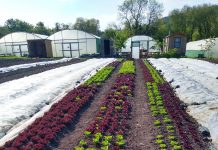September is about harvesting, planning new plants when existing crops are finished, and judicious watering where required.
A hot and sunny August made a big difference to growth and fruiting—such an abundance we have hardly been able to go on holiday!
Regular watering of ‘Defender’ courgettes (soil not leaves) and French beans has paid off with massive yields. While the dwarf ‘Sonesta’ French beans gave a fair crop outdoors, the ones in the polytunnel had 300% more. The dwarf varieties fruited all in one go, whereas Cobra climbing up 8’ bamboo wigwams are giving big harvests and set to continue until the last few in October.
So you can tell we like French beans, which means we give them great attention. Yet although our indoor tomatoes have done well in the heat, I managed to under-water them in the hope there would be less side shoots. Disaster, less fruit has set and blight has taken over as a result of stress. It is a good lesson to pay attention to detail, but luckily the blight around here rarely attacks our fruits, mysteriously it only affects the leaves until late October.
We have not watered sweetcorn, parsnips or winter brassicas. The last two are storing sunshine energy and will grow strongly when the rain arrives. But there is a point, especially if you haven’t enriched the organic matter in your soil, when the plants get dangerously weak, and then you really should water them.
Sprinkler systems are wasteful, better to water the soil around the plants with a watering can. This makes you think about how much water you are using, is much more efficient and may encourage you to use as much rainwater as you can. Our leeks would like water, but we won’t give it to them unless rust gets going, when we will water the soil not the leaves.
While it is generally more fun to concentrate on your successes, we have plenty of failures this year. My polytunnel aubergines refused to set fruit, I probably let them grow too big and flower too much. Nest year we will keep them pruned hard, which we have done with Sweetheart melon, and now have many fruits ripening.
And why did our potatoes have no blight in late August. The wet June saw the plants grow big and healthy, and perhaps the almost dry weather since (except for 1” rain on 1st August) has helped. The tubers we have been digging are big too.
The transfer from summer to winter vegetables is gradual if September is sunny. As crops such as sweetcorn are harvested be sure to fill the space with transplants or even sowing straight into the soil early in the month. You can even transplant between plants that will soon finish such as lettuce.
Transplant Spring cabbage and overwintering onion sets. Sow leaf crops such as true spinach, chervil, dill, coriander chard, rocket, and orientals like mustards, Pak Choi, Tatsoi and Mizuna may produce good leaves through the winter and certainly in early spring. They will produce more and fleshier leaves in a greenhouse.








